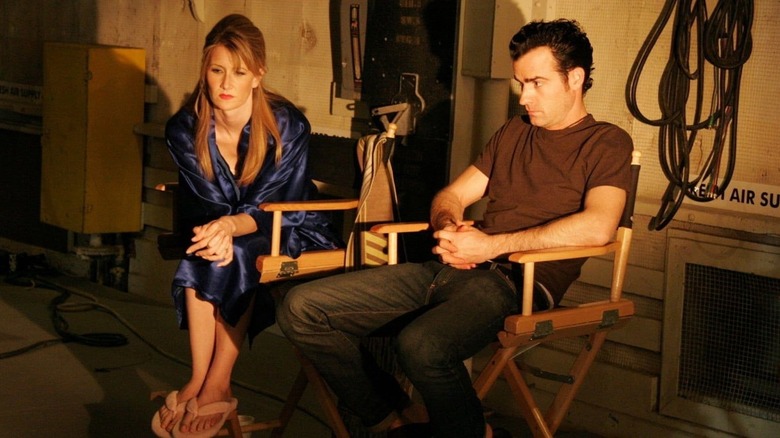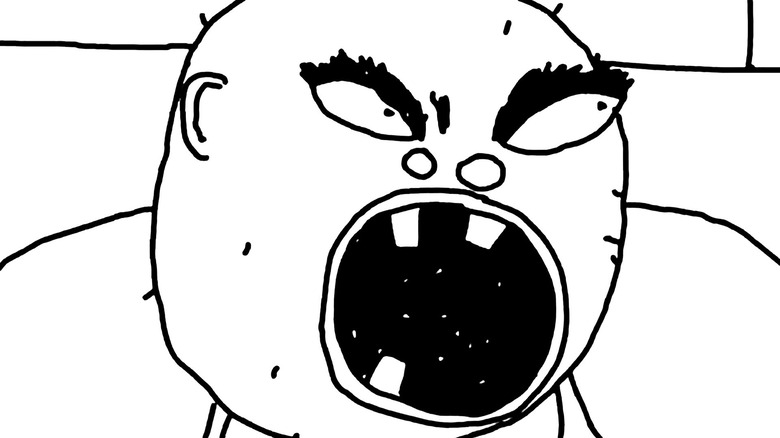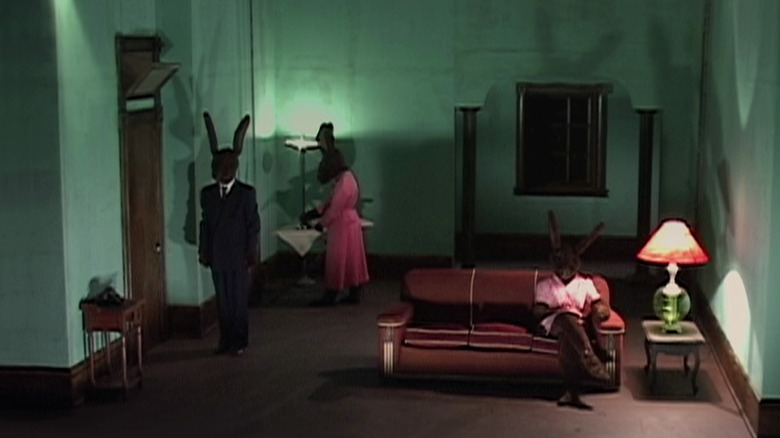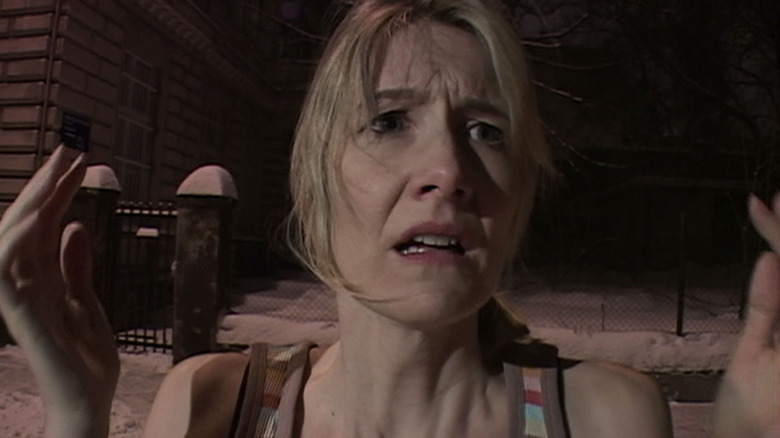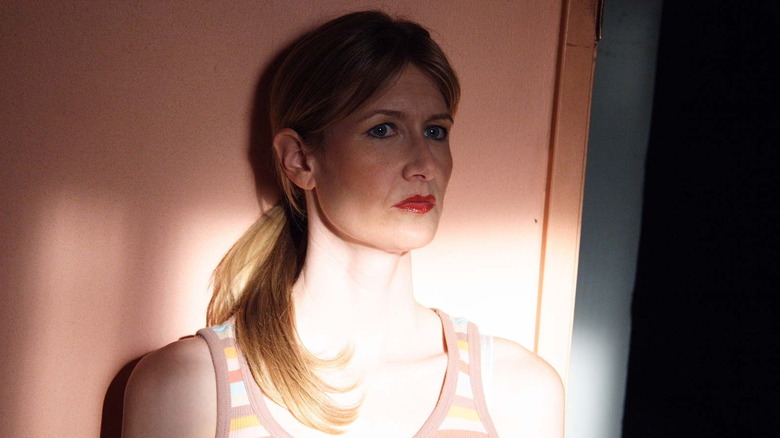How Inland Empire Tied Together Three Unrelated David Lynch Shorts
As any home media hunters of a certain age know, securing a VHS copy of David Lynch's 1977 debut feature "Eraserhead" was a Herculean task. Cassettes were rare, and the ones the public could access were typically living in libraries or video stores who would not sell them to you. If you were willing to shell out $80 to $100, in 1992 dollars, then maybe you could cut a deal. Some resourceful collectors could scoop up a well-worn Japanese LaserDisc, but only the more extreme collectors owned LaserDisc players. "Eraserhead" was, for many years, effectively out of print.
After the release of "Mulholland Drive" in 2001, however, Lynch began examining new types of media as well as the ever-growing DVD market and decided that it was high time to keep up with an evolving landscape. In 2002, Lynch — owning the rights to "Eraserhead" as well as his early short films — remastered and released a pair of tiffany DVDs, available for $40 each. They came in artistic, outsize boxes and were the pride of any DVD collector. The DVD remastering coincided with the launch of a brand new website where the filmmaker could explore in ways he hadn't previously.
The David Lynch website was a strange place in the early 2000s, and might have proved to be ahead of its time. For a subscription fee, a rarity at the time, one could access exclusive weather report videos, usually no longer than 30 seconds. You could also find exclusive interview footage, as well as documentary shorts of Lynch making quinoa at home.
This was also where the creative process that would fuel "Inland Empire" began to form.
DavidLynch.com
Lynch also used his website to distribute new experimental film projects. His animated series "Dumbland" debuted on the site (seen above). Lynch also offered bizarre ringtones, available for purchase. The filmmaker essentially predicted the Patreon model before there was ever a Patreon. These days, Lynch has continued his weather reports on his YouTube channel.
Notably, Lynch debuted a series of sitcom-like shorts called "Rabbits." The shorts featured humanoid bunny people — played by Laura Elena Harring, Naomi Watts, and Scott Coffey — seen in a long shot, enacting an "Ozzie and Harriet" style TV special in a shadowy, threatening place. The rabbits rarely spoke, and nightmarish orchestral chords played on the soundtrack. Whenever a rabbit entered the room, a wild applause track would keep them in place for a few moments. The visual fidelity is low, as Lynch was testing out 2000-era consumer grade digital cameras.
A lot of Lynch's movement toward new media in the early 2000s was his growing disillusionment with physical film. While he was still impressed with the deep beauty of the medium, he is on record saying that film was "a dinosaur." He once said in Variety that he was officially done with celluloid, feeling that waiting for a film to be printed and screened was a slow, days long process that wasn't amenable to invention on the fly. Digital film, he felt, allowed for a much, much faster creative process. He could have an idea in the morning and have a completed short by the late afternoon. The idea-to-film pipeline was now practically nonexistent, and Lynch preferred it that way.
Schools of fish
In an interview with the A.V. Club in April of 2022, Lynch elucidated further on his creative process:
"When you write a script, at least what my experience has been, you don't suddenly see the whole script and spit it out and type it out with no typos, just perfect, in one sitting. That never happens, never will happen. You get an idea, and you write that one out, then you're going along, you don't have any script, you had an idea and you wrote it out. Then you go along, you get another idea and you write it out. Now you have two ideas, but you don't have a script"
As a creative person, Lynch's mind seems to reach in several directions at once. Ideas, Lynch feels, are sacred beings, a belief he has tied to his involvement with transcendental meditation. Lynch seems to follow the model laid out by Plato that all ideas exist in a metaphysical realm, and the human mind reaches into that realm and extracts them. If one has an idea, Lynch feels one must pursue it. Deferring ideas for later is, for the filmmaker, a painful process. He continued:
"You go along a little bit more and you get a third idea, you write it out. And you look and you say, "Wait a minute, I have three ideas, and none of them relate to one another." Fine! No problem. There's no script, just three ideas that don't relate. You go along and you get a fourth idea, and this fourth idea relates to the first three, and you say, "Oh, something's happening." And then, when something starts happening, more ideas flood in, quicker! Quicker they come, like schools of fish, schools of fish!"
This simile of ideas as fish is the basis for the title of Lynch's book "Catching the Big Fish: Meditation, Consciousness and Creativity."
It wasn't complete until it was complete
The "film ideas as they come" approach made for a very unusual shooting process for the film that was to become "Inland Empire." The "Rabbits" shorts, it seems, were part of a larger, longer crreative process than even Lynch realized at the time. As he shot more and more of "Inland Empire," a more coherent singular work began to emerge. "Rabbits" was definitely part of it. He would also call up his friend Laura Dern, star of "Blue Velvet" and "Wild at Heart," to ask her to come film a scene he had invented. Dern was game, and would film seemingly unconnected monologues, unusual outdoor scenes, and other dramatic vignettes without her or Lynch knowing how they connected.
Eventually, at least as far as Lynch was concerned, they did. Lynch said:
"The only difference was that I happened to shoot each of those first three ideas. Not only did I write them down, but I shot them. I built a set, or I went to a location and I shot them, and they didn't relate ... But now the whole thing has come together, and I'm starting to write, and I've got the whole thing now coming. That's the way it happened. So it wasn't that I had no script. I had a script all along the way. It just wasn't complete until it was complete, the way every other script is."
The final cut of "Inland Empire" ran a full 180 minutes, and the filmmaker was pleased with the results. The film also starred Justin Theroux, Jeremy Irons, Harry Dean Stanton, Grace Zabriskie, Diane Ladd, William H. Macy, and many others.
So what is it?
If one was driving down Sunset Boulevard late in 2006, one might run into David Lynch himself, sitting on a lawn chair on a nondescript patch of grass. He had a live cow with him. He sat in front of a banner that hyped up Dern's performance in "Inland Empire" as being worthy of an Academy Award. Why a cow? Because when we think of cheese, we should think of where it started. His comments to passersby were of a similar nature.
Dern was not nominated for an Academy Award that year. Dern wouldn't win an Oscar until 2020 for her performance in "Marriage Story."
"Inland Empire," from a close examination, appears to be about the nature of acting. Lynch was fascinated by ideas of identity, as his films "Lost Highway" and "Mulholland Drive" attest, and he admired the way actors can subsume their own identity in favor of one they invent. If one vanishes into a role, and by extension, if an artist vanishes too deeply into their art, where do they go? Whom do they become? "Inland Empire" is about an actor's landscape of ever-shifting identity. This is a blood sacrifice. It's no wonder that Dern dies on a street in Los Angeles at the end of the movie, only to emerge out of a television to a weeping audience.
"Rabbits" was not just a series of shorts about bunnies. It was, it seems, a deep look into the way entertainment operates and the way performers are performing animals. "Inland Empire" was one of the best films of its year.
